How to paint a heating battery: step-by-step technology for painting radiators
Old batteries lose their aesthetic appearance over time, rust appears, cracks appear on the coating, paint peels off. Agree, changing the radiator in this case is not a good idea. It’s much easier, faster and more economical to repaint the battery. Moreover, updating the appearance of the heater is quite easy.
We will help you in choosing the right enamel composition, explain how to prepare and how to paint the heating battery correctly. And also denote the nuances that should be considered when working with different types of radiators.
The proposed photo ideas will inspire you to choose an interesting solution and implement a design idea.
The content of the article:
Paint Requirements
Not always there is a material, and in many cases a technical opportunity to put a new radiator. It is easier to refresh the outside of the heating appliance if it is still able to serve. In the event that the battery has already been repaired or it does not heat well, then it is better replace with a new one.
The painting process itself is not particularly difficult, but this does not mean that you can buy any composition and immediately begin to restore the attractiveness of the radiator.
Paint needs to be selected according to certain parameters, and the battery must be carefully prepared. If this is not done, then the new coating will not last long, and soon the process will have to be repeated again.
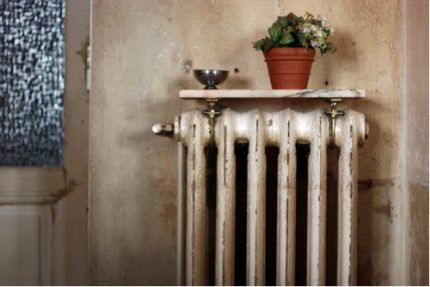
When choosing a composition, it is best to dwell on options specifically designed for heating appliances.But if the label does not have such an inscription, it is worthwhile to carefully study the instructions and find data on its heat resistance.
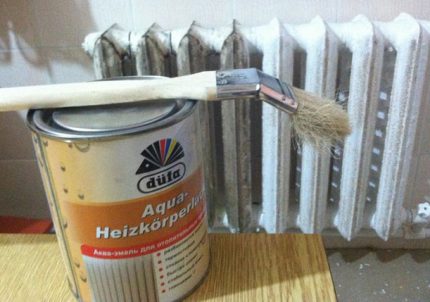
Paint requirements:
- Heat resistance. The composition applied to the radiator body must withstand temperatures up to 80-90 degrees and be faultless for the time promised by the manufacturer.
- Adhesion. It is necessary that the composition has a good adhesion to the painted surface. It did not exfoliate when heated and alternately heated / cooled.
- Corrosion protection. The composition must contain anti-corrosive substances so that the coating that contacts directly with the housing does not cause its destruction.
- Color fastness. Unconditional condition since radiators are painted for aesthetic purposes, among other reasons.
- Abrasion resistance. From direct contact with a variety of furnishings, dried things, etc. the coating should not be thinned.
- Safety. It is very important that there are no unhealthy components in the composition.
Good paint for radiators must meet all the requirements, and not individual points.
Varieties of battery stains
When painting the battery, first of all, it is necessary to pay attention to the technical component of the dye. But aesthetic characteristics play an important role.
The benefits of acrylic dyes
To kill two birds with one stone immediately allow acrylic paints, which belong to the group of water-based dyes. Their undoubted advantage is that they do not emit harmful substances, have no smell, are safe for humans.
They dry quickly (approximately 30 minutes at a temperature of 18-23 degrees), have water-repellent properties, form a very durable coating, resistant to mechanical stress.
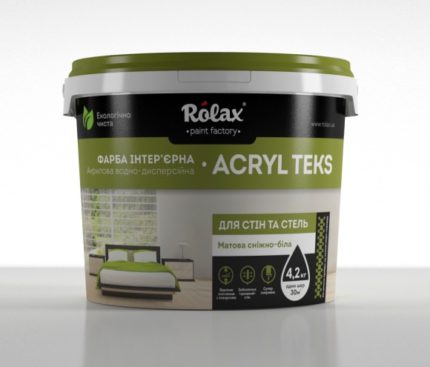
Well, and perhaps the most important thing is that they can withstand high temperatures perfectly, preserving their qualities and not changing their original appearance for seven to eight years.
During this time, they will not acquire a yellow tint, will not crack or peel. The whiteness of the acrylic dye is 96%, the color is very juicy and bright, and the surface looks like a plastic coating with a slight sheen.
Features of alkyd compounds
Alkyd paints are highly heat resistant and are also suitable for painting batteries. They are superior in strength to acrylic compounds, have anti-corrosion properties, and they lie well on the surface, forming an even and beautiful coating.
However, they are not as safe as waterborne paints. The solvent included in their composition causes an unpleasant odor that remains in the room for at least a day.
Paints dry quite slowly, and a specific smell can persist even after drying. Alkyd dyes can only be used in a well-ventilated area, and it is advisable to leave it altogether until the smell is completely weathering.
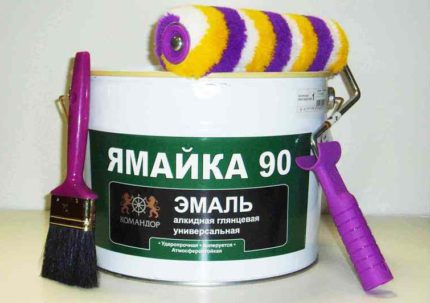
Another significant drawback is that the paints retain their color relatively briefly and begin to turn yellow over time. If you still decide to paint the battery with alkyd paint, it is better to choose a composition that forms a glossy finish.
In this case, the period during which the radiator will remain white increases by approximately 20%, compared with matte and semi-matte paints.
Other types of paint for heating appliances
For painting heating radiators, paints based on aluminum and silicate resins are suitable, forming a dense and elastic layer on the surface, on which cracks do not appear even at temperature extremes.
Silicate paints are characterized by high adhesion and do not require preliminary priming of the surface, they are designed to work at very high temperature conditions. Their disadvantage is a strong unpleasant odor.
Another type of paints that you should dwell on is hammer paints, which are a type of alkyd composition. They form a rather interesting, but very specific coating. After applying them, the surface is not smooth, but as if beaten with a hammer (hence the name) or with the effect of chasing.
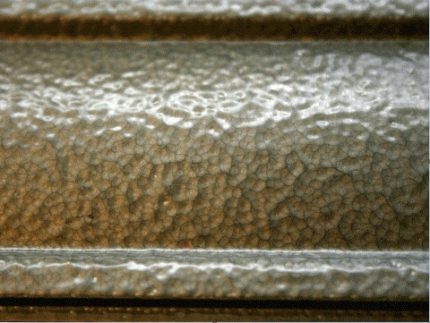
A significant advantage of hammer dyes is that the inhomogeneous texture will make invisible various roughnesses, bumps and other minor defects of radiators.
This property is especially valuable when it comes to painting old cast iron batteries Soviet era, the rough surface of which is completely hidden behind the original coating.
Very often, silverfish is used to paint radiators, which is a mixture of varnish and aluminum powder. It perfectly withstands high temperatures, it can be applied both to the primer and to the old coating. However, the paint has a persistent smell, so during and after its application, the room should be well ventilated.
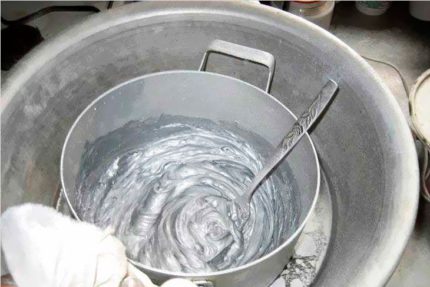
Aluminum powder is an explosive substance. The self-cooking process is quite risky. You should not resort to it if the house has easily combustible structures, and even more so small children.
The procedure for preparing the battery for painting
Preparation of the surface for painting is a stage no less important than the painting itself. Take it responsibly, because all the flaws and shortcomings that you make during the preparation will certainly affect the quality of the color and appearance of the battery. Immediately, we note that all work must begin only after the end of the heating season.
Methods for removing dust and grease
First of all, the battery must be cleaned of dirt and dust accumulated in it. This can be done in a dry way with a vacuum cleaner or a brush, and in the wet method with water and detergents. If there are layers of fat on the radiator, rinse them with conventional dishwashing detergents.After that, let the battery dry and proceed to the next step.
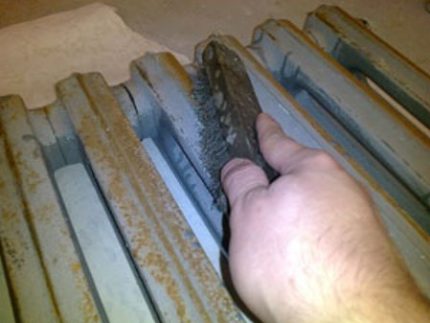
Now it is necessary to remove rust and old cracked paint from the heater.
How to do it? There are two ways: mechanical, but it is quite long and laborious and chemical - simpler, but it has some nuances that will be described below.
Mechanical removal of old coatings
To remove the paint mechanically, you will need a metal brush. Everything is simple here - take it in your hands and rub it until you get tired, and you get tired pretty quickly, so it’s better to use a more productive method. A grinder will help you in your work with special nozzles - a brush-kratsovka or a cleaning circle.
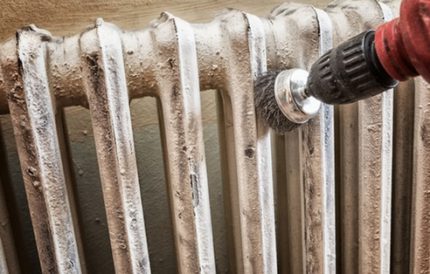
Using this power tool, you can clean old paint in a few hours. But be careful, do not work at high speeds, especially for radiators made of non-ferrous metals, because together with the paint you can imperceptibly damage the surface of the battery itself.
It is not necessary to completely remove the paint. On even, non-cracked areas, a new coating can be applied.
How to get rid of paint with chemicals?
Now we will analyze the chemical method. It consists in washing off the paint with special compositions, which are in the form of a gel, paste or aerosol. When using gel-like and paste-like products, apply them to the entire surface of the battery with a brush with natural bristles, and then cover with a plastic wrap to achieve the best effect.
The exposure time depends on the product used and can be from fifteen minutes to several hours. The exact time is indicated on the label. After the paint has softened, scrub it off with a spatula, and the remainder with a metal brush.
Aerosol washes are convenient in terms of application, they are easy to handle even hard-to-reach areas of the radiator. The principle of operation is the same as that of helium compounds - after a certain time (15-40 minutes, depending on the product), the paint softens and is easy to remove with a brush.
Before applying, do not forget to close the surrounding interior, floor and walls.
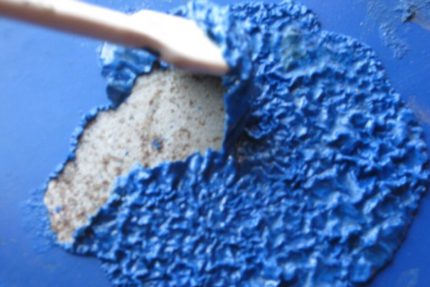
However, chemicals are not as harmless as it seems at first glance. Firstly, they have a sharp unpleasant odor and should only be used in a well-ventilated area. It is advisable to wear a respirator and protective gloves before work.
Secondly, it is not known how the metal behaves when interacting with an aggressive chemical composition. Perhaps he will react with him, and after washing off, you will find a damaged surface.
Old cast-iron batteries are not afraid of modern chemicals. But here you need to be afraid of something else: earlier, hemp was used to seal radiators (natural material made from flax or hemp), but it can be very easily consumed by chemistry.
As a result, when the heating season comes, water may splash out of all the compounds. Therefore, decide for yourself which method of cleaning from the old paintwork is more suitable for you.
Grounding rules
After the old paint is removed, before proceeding directly to the painting of the radiator, you must go through a number of procedures. To remove cracks, scratches and other small flaws, smooth steel or copper surfaces must be cleaned with sandpaper. Cast iron batteries are best treated with a wire brush.
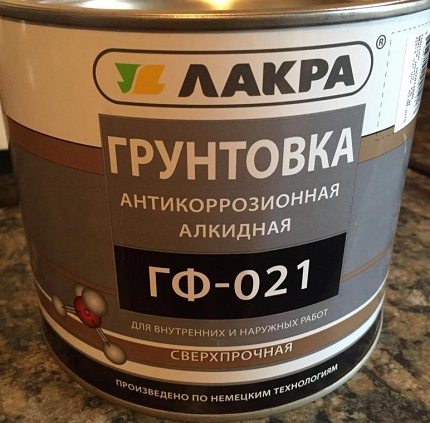
Now the radiator needs to be degreased and primed. When choosing a primer, it is necessary to choose a tool designed for metal, which has anti-corrosion properties and is compatible with paint.
For example, GF-021 soil is well combined with domestic paints and varnishes. If a dye of imported production is used to paint the heating battery, a Dulux or Sigma primer may be recommended.
Heating radiator painting
So we got to the main stage - direct staining. It is advisable to adhere to the following rule: it is better to apply two thin layers of paint than one thick one.
The first time it is unlikely that you can get the perfect surface, and if you apply the paint in a bold layer, the effect will be the opposite: thick and ugly smudges form on the battery.
General staining technology
For painting, get at least two brushes: one ordinary, the other for hard-to-reach spots with a long bent handle. With it, it is convenient to apply paint to the rear walls and internal surfaces of the battery. Before work, fluff the bristles so that loose hairs fall out.
First, the upper parts are painted inside the battery, then the lower ones. After that proceed to the outer surface. She is also painted from top to bottom. If you start from below, then drops will fall on the painted surface. The second coat of paint is applied only after the previous one has completely dried.
How long it will take depends on the paint, usually this parameter is indicated on the label. If the first layer turned out uneven, then when it dries, treat the surface with a sandpaper, removing all irregularities and smudges.
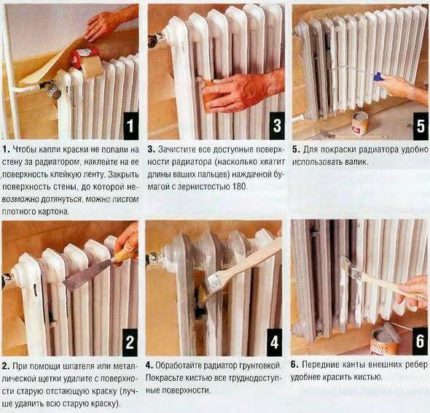
The nuances of painting aluminum radiators
All previous tips related to painting cast iron, copper and steel batteries. How to paint aluminum heating radiator? But first, it’s better to answer the question: is it worth it at all?
Modern aluminum appliances they are painted in the factory on a professional level with special powder paint. Home painting will not be able to provide a high-quality smooth coating.
In addition, if the radiator is still under warranty, then after painting at home, the manufacturer's warranty is terminated.
But most likely it would hardly occur to anyone to paint a new radiator. If the device is damaged as a result of transportation or installation, chips and cracks appear on it, which greatly damage the appearance, you can use auto enamel.
It should be noted that auto enamel most effectively paints and dries quickly only on hot batteries. Drying time at 130 ° C is 20 minutes, and at 20 ° C - up to two days. You need to work in a respirator and with windows open, spray should be at a distance of 20-30 cm from the surface. Do not keep the jet in one place for a long time, otherwise smudges will appear.
Chips and dents can also be removed from the aluminum radiator using automotive putty. Pre-degrease the surface and treat it with a primer. Then brush with putty of the desired shade.
If you decide to completely repaint the battery, then removing the old paint is not necessary. Degrease and prime the surface and apply two coats of alkyd or water based paint using a spray gun.
Alternative heating radiator decor - installation decorative screen.
Interesting battery coloring ideas
The white radiator is a classic that we have been accustomed to since the Soviet era, when almost all houses were equipped with the same cast-iron batteries.
The color of the heater, if it affects the heat transfer, is only to a very small extent, therefore, nothing prevents the radiator from being painted in accordance with the interior of the room.
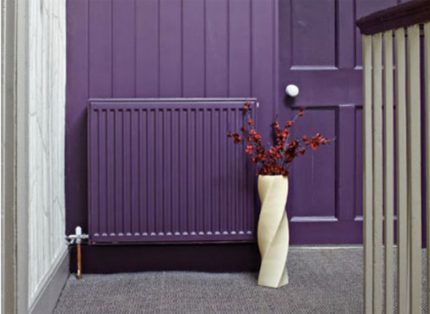
Today you can find many interesting design solutions, where the radiator is one of the decorating elements that blends harmoniously into the surrounding space.
On the contrary, you can build a composition using contrast, and make the battery an accent that attracts attention, painting it in a bright juicy color.

Today it is very fashionable to paint objects using the ombre technique. Its essence lies in the fact that the first sections of the battery are painted in pale, barely perceptible shades, all subsequent ones are a tone or two darker, and very bright saturated colors are used for the last sections.
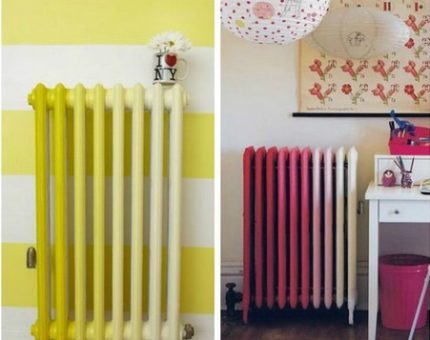
The most creative design ideas can be embodied in a children's room.
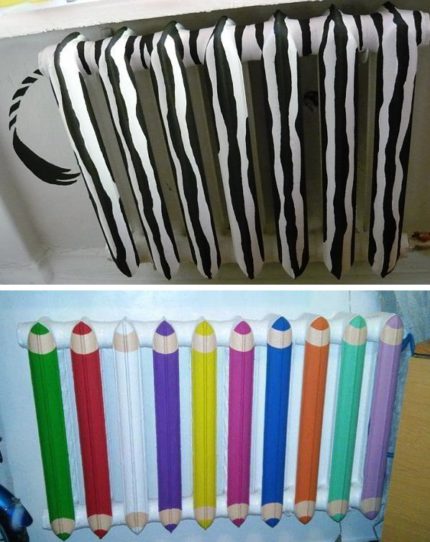
Conclusions and useful video on the topic
To make it easy for you to figure out how to paint the battery, we suggest that you familiarize yourself with the video materials on this topic.
The process of removing old paint from a cast-iron battery is very well presented in this video:
You will learn how to properly paint a heating radiator if you watch the video:
Original ideas for creative painting of cast-iron radiators you can learn from the following video:
To paint the battery, it is not necessary to have special skills. And although there are certain difficulties in this, as in any other work, they are simply enough to assimilate. Observing the technology of painting and knowing all the nuances of work, an excellent result will be guaranteed.
Do you have practical skills in painting batteries? Perhaps you have encountered any difficulties at work or want to ask a question? Please leave comments on the publication. The feedback form is below.

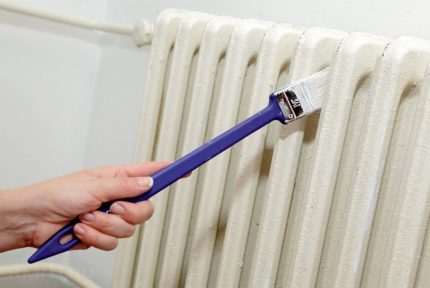
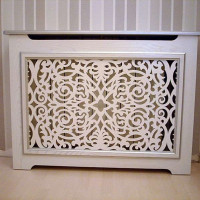 How and what is better to close the heating battery: options for masking radiators
How and what is better to close the heating battery: options for masking radiators 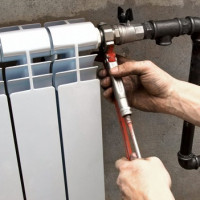 Installing heating batteries: do-it-yourself technology for the correct installation of radiators
Installing heating batteries: do-it-yourself technology for the correct installation of radiators 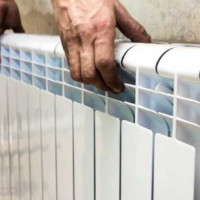 Replacing heating radiators: a guide for dismantling old batteries and installing new appliances
Replacing heating radiators: a guide for dismantling old batteries and installing new appliances 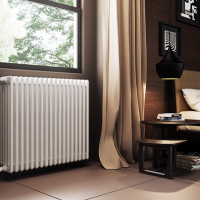 What heating batteries are best for an apartment: classification of radiators and their features
What heating batteries are best for an apartment: classification of radiators and their features 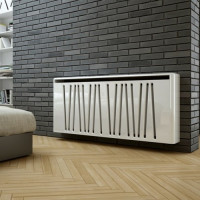 Decorative screens on the heating battery: an overview of the different types of grilles + selection tips
Decorative screens on the heating battery: an overview of the different types of grilles + selection tips 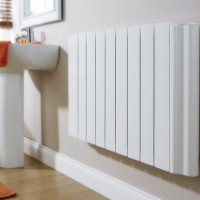 Vacuum heating radiators: overview of types, selection rules + installation technology
Vacuum heating radiators: overview of types, selection rules + installation technology  How much does it cost to connect gas to a private house: the price of organizing gas supply
How much does it cost to connect gas to a private house: the price of organizing gas supply  The best washing machines with dryer: model rating and customer tips
The best washing machines with dryer: model rating and customer tips  What is the color temperature of light and the nuances of choosing the temperature of the lamps to suit your needs
What is the color temperature of light and the nuances of choosing the temperature of the lamps to suit your needs  Replacement of a geyser in an apartment: replacement paperwork + basic norms and requirements
Replacement of a geyser in an apartment: replacement paperwork + basic norms and requirements
In general, it is also necessary to monitor the condition of the radiators of the heating circuits. It was painted in dozens of layers in the Soviet Union and did not really pay attention to the aesthetics of their appearance. By the way, do not try to clean the old cast-iron radiators that have worked for more than a dozen years. Most likely, after such a cleaning, the seams will leak.
It’s better to close them at all than to paint or decorate even worse, as in video and photo. This is not at all aesthetically pleasing in terms of interior design. No matter how you paint, there will be bumps and roughness on them. Yes, and the paint can lie badly, this whole thing looks terrible. But if it’s already impatient, remove and clean the old layer well so that everything works well and looks optimal.
In our city there are houses built in the 70s of the last century, awaiting relocation. And the inhabitants are in no hurry to repair something there. So there are such terrible radiators. If technically they are serviceable, you can paint with a special paint for radiators, heat-resistant alkyd. First sand, degrease with white spirit, then paint. It is advisable to do this with gloves and a respirator. The paint has a pungent odor.
About degreasing, that's all you say correctly. But the paint for radiators is odorless. Last year he painted, so even the child was at home and everything is fine. Two hours later it has dried and does not smell. And it holds well.
We live in an old apartment, from the time of the Soviet Union, cast-iron batteries were installed here from the very beginning. If before they looked more or less normal, now they have rusted and lost their aesthetic appearance. They thought at first to clean and color them. But still, they decided to install new, aluminum, more modern ones. By the way, their appearance is much prettier than that of cast-iron. But if there are no funds to buy new ones, you can simply paint the old ones.